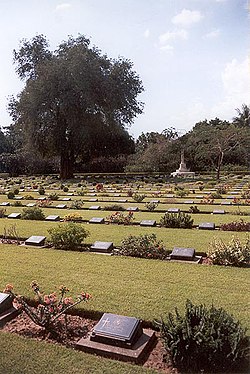| Chungkai War Cemetery | |
|---|---|
 War graves cemetery | |
 | |
| Details | |
| Location | |
| Country | Thailand |
| Coordinates | 14°00′19″N99°30′53″E / 14.0052°N 99.5146°E |
| Type | Military Cemetery |
| Owned by | Commonwealth War Graves Commission |
| No. of graves | 1,692 [1] |
| Find a Grave | Chungkai War Cemetery |
Chungkai War Cemetery, also known as Chung Kai War Cemetery, is a war cemetery in Tha Ma Kham near Kanchanaburi, Thailand. Established in the 1950s, the cemetery hosts the graves of 1,426 British and 313 Dutch prisoners of war who died during World War II. [1] It was originally a prisoner of war camp on the Burma Railway.